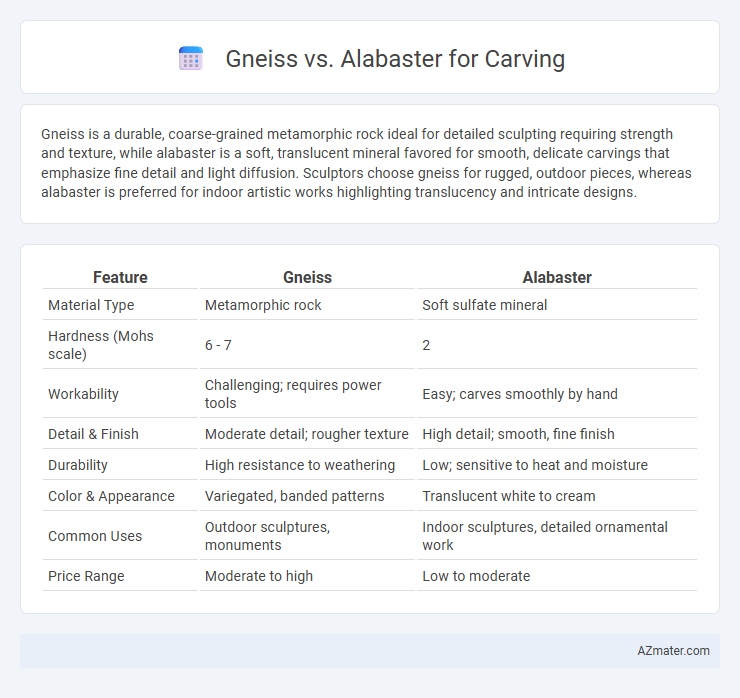Gneiss is a durable, coarse-grained metamorphic rock ideal for detailed sculpting requiring strength and texture, while alabaster is a soft, translucent mineral favored for smooth, delicate carvings that emphasize fine detail and light diffusion. Sculptors choose gneiss for rugged, outdoor pieces, whereas alabaster is preferred for indoor artistic works highlighting translucency and intricate designs.
Table of Comparison
| Feature | Gneiss | Alabaster |
|---|---|---|
| Material Type | Metamorphic rock | Soft sulfate mineral |
| Hardness (Mohs scale) | 6 - 7 | 2 |
| Workability | Challenging; requires power tools | Easy; carves smoothly by hand |
| Detail & Finish | Moderate detail; rougher texture | High detail; smooth, fine finish |
| Durability | High resistance to weathering | Low; sensitive to heat and moisture |
| Color & Appearance | Variegated, banded patterns | Translucent white to cream |
| Common Uses | Outdoor sculptures, monuments | Indoor sculptures, detailed ornamental work |
| Price Range | Moderate to high | Low to moderate |
Introduction to Gneiss and Alabaster
Gneiss is a durable, coarse-grained metamorphic rock known for its distinct banding and hardness, making it a challenging yet rewarding material for carving intricate designs. Alabaster, a soft, translucent form of gypsum or calcite, offers ease of carving with fine detail and smooth finishes, preferred for delicate sculptures and ornamental pieces. Both stones provide unique textures and visual effects, but their differing hardness levels and workability significantly influence artistic choice.
Geological Origins and Formation
Gneiss forms through high-grade regional metamorphism of pre-existing igneous or sedimentary rocks, characterized by its pronounced banding and coarse-grained texture composed mainly of feldspar, quartz, and mica. Alabaster is a fine-grained, translucent variety of gypsum or calcite, created by the recrystallization of evaporite deposits in sedimentary environments. The mineralogical differences and formation conditions result in gneiss's hardness and durability, while alabaster's softness allows for intricate carving details.
Physical Properties Comparison
Gneiss exhibits high hardness and durability, making it ideal for detailed carving and long-lasting sculptures, with a Mohs hardness of 6-7 and a coarse, foliated texture that adds visual depth. Alabaster, significantly softer with a Mohs hardness of 2, allows for smooth, intricate carvings but is more prone to scratching and weathering due to its fine-grained, translucent structure. The comparative density of gneiss ranges from 2.6 to 2.9 g/cm3, offering robustness, while alabaster's lower density around 2.3 g/cm3 provides easier handling but less structural strength.
Workability and Carving Techniques
Gneiss offers moderate workability due to its coarse grain and foliated texture, requiring robust carving tools and techniques such as chiseling and hammering to achieve detailed forms. Alabaster is highly prized for its softness and fine-grained structure, allowing fine detail with hand tools like rasps and files, making it ideal for intricate and delicate carving projects. Sculptors often choose alabaster for smooth finishes and elaborate designs, while gneiss suits more rugged, bold artistic expressions.
Color and Aesthetic Appeal
Gneiss offers rich, earthy tones with layered textures that create a visually dynamic surface, making it ideal for sculptures requiring naturalistic aesthetics. Alabaster provides a smooth, translucent finish in soft white or cream hues, lending a delicate and luminous quality perfect for fine, detailed carvings. The choice between gneiss and alabaster depends on the desired visual impact, with gneiss emphasizing rugged, organic patterns and alabaster highlighting refined elegance.
Durability and Longevity in Sculptures
Gneiss offers superior durability in sculpture due to its coarse-grained, foliated structure, which resists weathering and mechanical stress better than alabaster. Alabaster, being softer and more porous, provides ease of carving but has lower longevity and is more vulnerable to moisture and environmental damage. Sculptors seeking lasting outdoor works typically prefer gneiss for its robustness, while alabaster suits detailed indoor carvings requiring fine detail but less exposure.
Cost and Availability
Gneiss offers a cost-effective option for carving due to its widespread availability in many regions, making raw materials easier to source for artists and sculptors. Alabaster, valued for its smooth texture and fine grain, tends to be more expensive because of limited quarry locations and higher demand for intricate, detailed work. While alabaster is preferred for delicate carvings, gneiss provides an affordable alternative with robust durability and sufficient availability for larger-scale projects.
Common Uses in Art and Architecture
Gneiss is commonly used in architectural applications such as building facades, flooring, and decorative stonework due to its durability and attractive banded appearance. Alabaster, prized for its fine grain and translucency, is predominantly used in sculpture and detailed carvings, making it a favorite medium for intricate artistic works like statues, reliefs, and ornamental designs. While gneiss serves both structural and aesthetic purposes in large-scale projects, alabaster is primarily valued for delicate, small-scale art pieces and interior decorative elements.
Notable Sculptures and Historical Examples
Gneiss, known for its durability and unique banded texture, was famously used in ancient Egyptian sculptures like the statues of Pharaohs, providing resilience against weathering. Alabaster, prized for its softness and translucency, was the medium of choice for delicate works such as the Dendera Zodiac in Egypt and numerous Renaissance religious sculptures. The contrasting properties of gneiss and alabaster have influenced their selection for notable carvings, with gneiss favored for monumental, enduring pieces and alabaster for intricate, detailed artistry.
Choosing the Right Stone for Your Carving Project
Gneiss offers durability and intricate grain patterns ideal for detailed, long-lasting sculptures, while alabaster provides a softer, smoother texture perfect for delicate, translucent carvings with fine details. Consider gneiss for outdoor or large-scale projects requiring structural strength, whereas alabaster excels in indoor settings where light enhances its unique translucency. Selecting the right stone depends on the desired finish, carving complexity, and environmental exposure of the final artwork.

Infographic: Gneiss vs Alabaster for Carving
 azmater.com
azmater.com